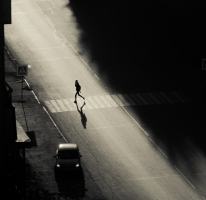
— New research shows automatic emergency braking with pedestrian detection doesn't work too great at night on roads without streetlights, although the systems do help during the day and on well-lit roadways.
AEB systems with pedestrian detection are supposed to warn drivers when pedestrians are at risk of getting hit, automatically applying the brakes to avoid or lessen the impact.
In a study from the Insurance Institute for Highway Safety (IIHS), researchers found automatic emergency braking with pedestrian detection lowered injury crash rates by 30% during the day.
But at night on roads without streetlights, vehicles with automatic emergency braking with pedestrian detection had the same crash risk as vehicles that weren't equipped with the technology.
The study is important because a third of pedestrian fatalities occur at night, and pedestrian crash deaths have increased 51 percent since 2009.
The test included a 2019 Subaru Forester, 2019 Volvo XC40, 2020 Honda CR-V, 2020 Hyundai Venue, 2021 Chevrolet Trailblazer, 2021 Ford Bronco Sport, 2021 Toyota C-HR and a 2022 Volkswagen Taos.
The vehicles use various systems for their AEB systems, including a single camera, a dual camera, a single camera and radar and radar only.
Each vehicle was tested twice, with the first test conducted with high-beam headlights and a second test with low-beam headlights.
Automatic emergency braking with pedestrian detection engaged during daylight reduced the chance of a pedestrian crash by 32% and by 33% in locations with artificial lighting during dawn, dusk and night.
Automatic emergency braking with pedestrian detection was also associated with a 32% reduction in the odds of a pedestrian crash on roads with speed limits of 25 mph or less, and a 34 percent reduction on roads with 30-35 mph limits.
However, there was no reduction at all on roads with speed limits of 50 mph or higher or when the vehicle was turning.
The Insurance Institute for Highway Safety says it is working on a dedicated AEB nighttime test and plans to publish the first official nighttime pedestrian crash prevention ratings later in 2022.




